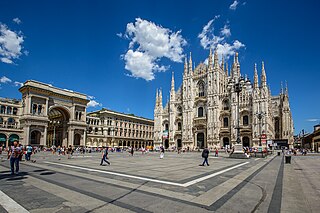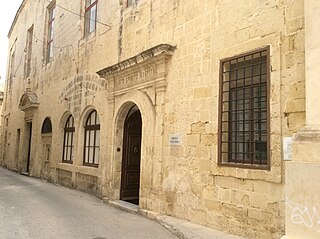History
The museum originates from a former anatomical museum, increased with the collections of Giovanni Carbonelli and Pietro Capparoni. The collections of the early museum, having educational purposes, are still in place. [1]
The idea for the creation of the current museum came from the International Exhibition of Retrospective Art, held in Rome in 1911. [2] The Institute for the Historic Museum of Healthcare Art (ISIDAS) was founded in 1920 and in 1934 turned into the Academy of History of Healthcare Art (ASAS), having the foundation of the museum among its goals. In 1929 the Institute of Santo Spirito granted a wing of the hospital, located in the former Corsia Alessandrina.
The museum included historical collections, which were joined to the former collection from the 1911 Exhibition; in 1931 the collection of Giovanni Carbonelli was added, in 1939 that of the General A. Cavalli Mulinelli and later the ones of Giuseppe and Orlando Solinas. [1]

The Sforza Castle is a medieval fortification located in Milan, northern Italy. It was built in the 15th century by Francesco Sforza, Duke of Milan, on the remnants of a 14th-century fortification. Later renovated and enlarged, in the 16th and 17th centuries it was one of the largest citadels in Europe. Extensively rebuilt by Luca Beltrami in 1891–1905, it now houses several of the city's museums and art collections.

Livio Agresti (1508–1580), also called Ritius or Ricciutello, was an Italian painter of the late Renaissance or Mannerist period, active both in his native city of Forlì and in Rome, where he died. He was one of the members of the "Forlì painting school".

Borgo is the 14th rione of Rome, Italy. It is identified by the initials R. XIV and is included within Municipio I.

Church of the Holy Spirit in the Saxon District is a 12th-century titular church in Rome, Italy. It is in Borgo Santo Spirito, a street which got its name from the church, placed in the southern part of Rione Borgo and has been connected since its foundation to the adjacent Ospedale di Santo Spirito in Sassia. The current holder of the titulus is Cardinal-Deacon Dominique Mamberti. It has been the official sanctuary of Divine Mercy since 1994.

Vincenzo Pacetti (1746–1820) was an Italian sculptor and restorer from Castel Bolognese, particularly active in collecting and freely restoring and completing classical sculptures such as the Barberini Faun — his most famous work— the Hope Dionysus and the Athena of Velletri and selling them on to rich collectors as finished artefacts. He was the brother of Camillo Pacetti.

The Hospital San Nicolás de Bari is a preserved hospital ruin, and it was recognized by UNESCO for being the oldest hospital built in the Americas. Construction began in 1503 in Santo Domingo, Dominican Republic, at the behest of governor Nicolás de Ovando. This grand project was in keeping with the desire to emulate European princely courts, and looked to Renaissance Italy for inspiration. At the time of its completion, the wards could accommodate up to 70 patients, comparable to the most advanced churches of Rome. It is likely that the model for the Hospital de San Nicolás was the large Ospedale di Santo Spirito in Sassia in Rome. The complex forms part of the Colonial Zone of Santo Domingo World Heritage Site.

The Torlonia Vase or Cesi-Albani-Torlonia Vase is a colossal and celebrated neo-Attic Roman white marble vase, 1.8 m tall, made in the 1st century BCE, which has passed through several prominent collections of antiquities before coming into the possession of the Princes Torlonia in Rome.

The Zone 1 of Milan, since 2016 officially Municipality 1 of Milan, is one of the 9 administrative divisions of Milan, Italy.

The hospital of San Giacomo in Augusta, also known as San Giacomo degli Incurabili was a historic hospital located in Rome.

Santa Maria Annunziata in Borgo, popularly known as Nunziatina, is an oratory of Rome (Italy), in the rione Borgo, facing on Lungotevere Vaticano.

The Hospital of the Holy Spirit is the oldest hospital in Europe, located in Rome, Italy. It now serves as a convention center. The complex lies in rione Borgo, east of Vatican City and next to the modern Ospedale di Santo Spirito. The hospital was established on the site of the former Schola Saxonum, a part of the complex houses the Museo Storico.

Porta Santo Spirito is one of the gates of the Leonine walls in Rome (Italy). It rises on the back side of the Hospital of the same name, in Via dei Penitenzieri, close to the crossing with Piazza della Rovere.

Palazzo Alicorni is a reconstructed Renaissance building in Rome, important for historical and architectural reasons. The palace, originally lying only a few meters away from Bernini's Colonnades in St. Peter's square, was demolished in 1931 in the wake of the process of the border definition of the newly established Vatican City state, and rebuilt some hundred meters to the east. According to the stylistic analysis, his designer had been identified as Giovanni Mangone, a Lombard architect active in Rome during the 16th century.
The Hospital of San Paolo, later known as the Spedale of the Leopoldine, is a former hospital from the 13th century, now museum of modern works, located on Piazza Santa Maria Novella number 10, in Florence, region of Tuscany, Italy.

Santa Maria del Rosario is a Catholic church in Alcamo, in the province of Trapani.

The Violin Museum, formerly the Stradivarius Museum, is a musical instrument museum located in Cremona. The museum is best known for its collection of stringed instruments that includes violins, violas, cellos, and double basses crafted by renowned luthiers, including Antonio Stradivari and Giuseppe Guarneri del Gesù.

Borgo Vecchio, also named in the Middle Ages Via Sancta, Carriera Sancta or Carriera Martyrum, was a road in the city of Rome, Italy, important for historical and architectural reasons. The road was destroyed together with the adjacent quartier in 1936–37 due to the construction of Via della Conciliazione.

The Ospedale di San Carlo was a building in Rome, important for historical and artistic reasons.

Borgo Santo Spirito is a street in Rome, Italy, important for historical and artistic reasons. From a historical point of view, it is considered the most interesting street in the Borgo district. Of medieval origin, it is linked to the foundation of the ancient fortified hospice for pilgrims from England, the Burgus Saxonum. The street houses the oldest Roman hospital, the Arcispedale di Santo Spirito in Saxia, which gave it its name. Heavily altered during the works for the opening of Via della Conciliazione, it nevertheless avoided the fate of the two parallel streets of Borgo Nuovo and Borgo Vecchio, both destroyed.

The Santo Spirito Hospital, originally known as the St. Francis Hospital, is a former hospital in Rabat, Malta which functioned from at least the 14th century to 1967. Since 1994, the hospital building has housed the head office of the National Archives of Malta.




















